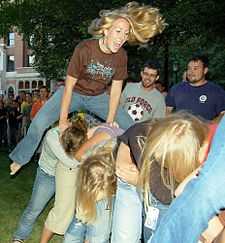Buck buck

Buck buck (also known as Johnny-on-a-Pony or Johnny-on-the-Pony) is a children's game with several variants.[1] One version of the game is played when "one player climbs another’s back" and the climber guesses "the number of certain objects out of sight."[1] Another version of the game is played with "one group of players [climbing] on the backs of a second group in order to build as large a pile as possible or to cause the supporting players to collapse."[1]
As early as the 1500s, children in Europe and the Near East played Buck, Buck, which had been called "Bucca Bucca quot sunt hic?".[2][3] Pieter Bruegel's painting "Children's Games" (1560) depicts children playing a variant of the game.[4][5]
In popular culture
Bill Cosby's 1967 album Revenge includes a track "Buck, Buck" in which he describes playing the game as a child. He mentions that in his hometown of Philadelphia it was called "Buck Buck," while in New York City it was known as "Johnny on the Pony." This track introduces Fat Albert, "the baddest Buck Buck breaker in the world," who "weighed 2,000 pounds" and could cause earthquakes when he ran down the street. The character would later become the basis for the cartoon series Fat Albert and the Cosby Kids which includes a buck buck episode (season 1 episode 6). The same story, in a slightly different form, is also included in Cosby's book Childhood.
References
Notes
- ↑ 1.0 1.1 1.2 "buck buck". Dictionary of American Regional English. Retrieved 20 January 2010.
- ↑ Spadaccini, Stephanie and John Farnsworth (2005). "Johnny Ride a Pony". The Big Book of Rules: Board Games, Kids' Games, Card Games, from Backgammon and Bocce to Tiddlywinks and Stickball. Penguin. pp. 221–222. ISBN 978-0-452-28644-3.
- ↑ Hindman, Sandra (September 1981). "Pieter Bruegel's Children's Games, Folly, and Chance". The Art Bulletin. LXIII (3): 470–471.
- ↑ "Game: Johnny On A Pony (Detail from Brueghel's Painting)". Elliot Avedon Virtual Museum of Games: Young Folk At Play (Children's Games). University of Waterloo. February 9, 2010. Retrieved 2011-11-15.
- ↑ Clements, Rhonda L. (1995). Games and Great Ideas: A Guide for Elementary School Physical Educators and Classroom Teachers. Greenwood Publishing Group. p. 10. ISBN 978-0-313-29460-0.
